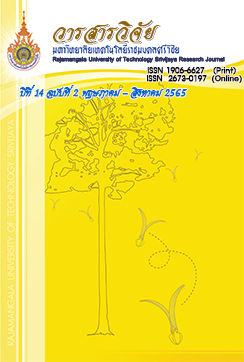Design and Simulation of Yagi-Uda Switched Beam Array Antenna to Enhance the Efficiency of LoRa Networks
Keywords:
LoRa networks, Yagi-Uda antenna, switched beam array antennaAbstract
LoRa is a type of Low Power Wide Area Networks (LPWANs) using low energy, which is important for internet of things technology that transfers data with low data rate and uses low energy for long distance transmission in the area without the use of internet signals or mobile phone networks. Thus, expanding of an area coverage by increasing antenna gain is significant. This research proposes the design and simulation of Yagi-Uda switched beam array antenna in the 920 MHz frequency band in order to enhance antenna gain compared to general LoRa antennas. Criteria of antenna design and simulation are orderly described according to the practical principle. As shown in the results, when increasing the number of elements in Yagi-Uda antenna and arranging Yagi-Uda antennas in the array form, the antenna gain can be increased and the longer distance transmission on the LoRa networks can be achieved. Meanwhile, beam steering can be performed by adjusting phases of signals.
References
Balanis, C.A. 2005. Antenna Theory Analysis and Design. John Wiley & Sons, Inc., Hoboken, New Jersey.
Dao, H.N., Krairiksh, M. and Le, D.T. 2016. A design of Switched-Beam Yagi-Uda antenna for wireless sensor networks, pp. 393-396. In 2016 International Conference on Advanced Technologies for Communications (ATC). Radio Electronics Association of Vietnam (REV) and the IEEE Communications Society (IEEE ComSoc), Bangkok, Thailand.
Khutsoane, O., Isong, B. and Abu-Mahfouz, A.M. 2017. IoT devices and applications based on LoRa/LoRaWAN, pp. 6107-6112. In IECON 2017 - 43rd Annual Conference of the IEEE Industrial Electronics Society. IEEE, Beijing, China.
Lui, H., Hui, H. and Leong, M.S. 2009. A note on the Mutual-Coupling problems in transmitting and receiving antenna arrays. IEEE Antennas and Propagation Magazine 51(5): 171-176.
Mushtaq, A., Gupta, S.H. and Rajawat, A. 2020. Design and performance analysis of LoRa LPWAN antenna for IoT applications, pp. 1153-1156. In 2020 7th International Conference on Signal Processing and Integrated Networks (SPIN). IEEE, Noida, India.
Naeini, M.R. and Fakharzadeh, M. 2017. A 28 GHz Beam-Switching Yagi-Uda array using Rotman lens for 5G wireless communications, pp. 2617-2618. In 2017 IEEE International Symposium on Antennas and Propagation & USNC/URSI National Radio Science Meeting. San Diego, CA.
Pham, C., Ferrero, F., Diop, M., Lizzi, L., Dieng, O. and Thiare. 2017. Low-cost antenna technology for LPWAN IoT in rural applications, pp. 1-6. In 2017 7th IEEE International Workshop on Advances in Sensors and Interfaces (IWASI). Vieste, Italy.
Pongnarin, S. 2009. Performance enhancement of GPRS systems for the mobile client using switched beam antennas. Degree of Master of Engineering in Telecommunication Engineering, Suranaree University of Technology. (in Thai)
Ramadan, A.A. and Gabriel, M.R. 2009. High-Gain Yagi-Uda antennas for Millimeter-Wave Switched-Beam systems. IEEE Transactions on Antennas and Propagation 57(11): 3672-3676.
Rehfuess, U. and Ivanov, K. 2000. Estimating the gains of adaptive antenna systems for GPRS and EDGE data services in GSM networks, pp. 3026-332. In 2000 52nd Vehicular Technology Conference (VTC). IEEE, Tokyo, Japan.
Ron, D., Lee, C., Lee, K., Choi, H. and Lee, J. 2020. Performance analysis and optimization of downlink transmission in LoRaWAN class B mode. IEEE Internet of Things Journal 7(8): 7836-7847.
Seye, M.R., Ngom, B., Gueye, B. and Diallo, M. 2018. A Study of LoRa coverage: Range evaluation and channel attenuation model, pp. 1-4. In 2018 1st International Conference on Smart Cities and Communities (SCCIC). IEEE, Ouagadougou, Burkina Faso.
Silva, J.M., Roy, S. and Fortier, P. 2003. The impact on the capacity of a GSM/GPRS system using space-time processing techniques, pp. 977-980. In Electrical and Computer Engineering, 2003. (CCECE 2003). IEEE, Montreal, Quebec, Canada.
Takano, T., Saegusa, K. and Hosono, H. 2013. A Large-Scale phased array antenna its applications and key technologies, pp. 1-6. In 2013 International Conference on Microwave and Photonics (ICMAP). IEEE, Dhanbad, India.
Thiele, G.A. 1969. Analysis of Yagi-Uda-Type antennas. IEEE Transactions on Antennas and Propagation 17(1): 24-31.
Toma, R. and Gemein, O.G. 2018. LoRa network for cities private and complete secured by design, pp. 1-5. In 2018 Global Internet of Things Summit (GIoTS). IEEE, Bilbao, Spain.
Zhou, Q., Zheng, K., Hou, L., Xing, J. and Xu, R. 2019. Design and implementation of open LoRa for IoT. IEEE Access 7: 100649-100657.
Downloads
Published
How to Cite
Issue
Section
License
Copyright (c) 2022 Rajamangala University of Technology Srivijaya Research Journal

This work is licensed under a Creative Commons Attribution-NonCommercial-NoDerivatives 4.0 International License.
The content and information in the article published in Journal of Rajamangala University of Technology Srivijaya It is the opinion and responsibility of the author of the article. The editorial journals do not need to agree. Or share any responsibility.







